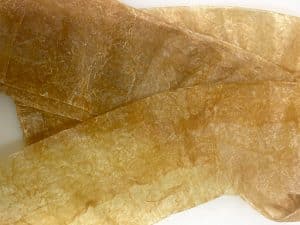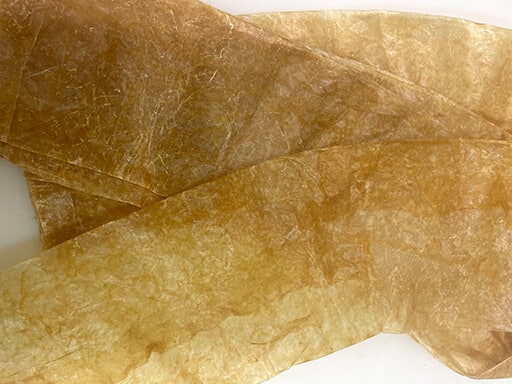What is the meaning of budello (casing)? The casing is the wrapper that encloses cured sausages—the so-called “outer skin”—which allows the meat inside to mature, giving it a determined shape. Casings can be made from animal intestines such as pork, lamb, or beef, or from synthetic materials like collagen.
All cured meats made from ground meat and intended to be preserved over time are stuffed using specific processes into specific wrappers, which, based on their origin, can be natural or artificial, and which can influence the taste and texture of the final product.
The use of pork casings dates back to antiquity when they were used to safely preserve meat and prevent food spoilage. Today, casings are still widely used in the food industry to produce salamis, sausages, and other meat products.
The choice of casing type depends on the product one wishes to create and the needs of the final consumer. Natural casings are generally preferred by consumers for their tradition and perceived superior quality compared to their synthetic equivalents.
Furthermore, natural casings have a lower environmental impact than their synthetic counterparts, as they are biodegradable and can be easily disposed of without leaving harmful residues in the environment.
How is a natural casing prepared?
Natural casings are derived from various animal species. Specifically, they are parts of the intestines of pigs, cattle, horses, or sheep that have a variable diameter from 4 to 15 cm and different shapes and sizes—in part because the use of one tract of the digestive system rather than another dictates the dimensions and appearance of the final product.
Casings hold the mixture introduced inside, allowing exchanges with the exterior, especially during the drying period, thanks to their porosity, tenacity, and adherence to the stuffed mass. By doing this, the contents are protected from external agents, and the harmful action of air and light—which is especially important for the fatty components—is limited.
Regarding the procedure, the intestines of the aforementioned animals are thoroughly washed and cleaned immediately after slaughter so that the organoleptic characteristics are not altered by fermentation. They are then treated for preservation with repeated salting and subsequently placed under salt in wooden or plastic barrels. By doing this, within hermetically sealed containers, the casings do not come into contact with light and air and are not altered. The contents are placed in large vats under brine for complete and thorough degreasing and curing, which takes two to three months to complete. At the end of this period, the casings are rinsed, washed, and classified based on their caliber, which determines their destination.
Casings are derived from pig and beef intestines
The various parts of the digestive system are used for different types of cured sausages. Below is a list of their various destinations:
- The bovine small intestine yields the budello torto (twisted casing) or budellino (small casing), which has a small diameter and is mainly used for small sausages like cacciatori (hunter’s salami). The porcine small intestine yields the same budello torto
- The large intestine (colon) yields the crespone, filzettoni, cresponetti, and the dritto (straight) porcine or bovine casing, used for medium and large caliber salamis. The equine colon yields the bindone.
- The cecum yields the bondeana or muletta, used to wrap coppa (cured pork shoulder) or to stuff various types of salami, including soppressa veneta and Finocchiona.
- The porcine rectum yields the gentile (gentle) casing, used for the production of numerous types of medium-sized salamis.
But it’s not just the parts of the digestive system that are used as wrappers. For example, the pig bladder can also be used for some more typical cured meats like culatello and, in some cases, even Calabrian ’nduja, or the trotters (zampe), including the little foot, are used to stuff zamponi.

Casing for cured meat
Artificial casings
Alongside natural casings, synthetic or artificial wrappers, which can derive from animal fibers or vegetable fibers, are increasingly being used.
Regenerated animal fiber casings are obtained from hides ( or derivatives of their processing) that are treated, washed, selected, cut into strips, and reduced to the state of fiber. All this happens before they are homogenized and mechanically reconstructed to obtain casings of a defined caliber and without seams.
Then there are cellulose-based vegetable casings, which are obtained from natural vegetable fibers (often cotton) that undergo the classic treatment for producing viscose. Following certain treatments, this viscose is regenerated, molded into the shape of a casing, plasticized with glycerin, and then dried.
So, what are the advantages of artificial casings? Certainly the consistency of the caliber, the lack of microbial flora, the absence of fats and odors, and the easy peelability of the slices. But alongside the advantages, there are also some disadvantages: the uniformity of shape and size, and the loss of the characteristic external appearance of many salamis that makes them typical.
How to use synthetic casing?
To correctly use synthetic casing, it is important first to take care of it during storage: it must be kept in a cool, dry place, away from heat and humidity. Furthermore, attention must be paid to its correct hydration before use.
To do this, simply soak the casing in lukewarm water for about 30 minutes, after which it will be ready to be filled with the ground meat and other ingredients necessary for the preparation of the sausage or cured meat. Once filled, the synthetic casing must be tied at the ends and sewn at regular intervals to prevent it from breaking during curing or cooking.
Where to buy salami casings?
To purchase casings, you can go to specialized butcher shops or food stores that sell products for cured meat production. Furthermore, there are also online shops that offer a wide range of natural casings of different diameters and lengths, depending on the specific use.
Budello meaning in Tuscany: what does it mean?
The term “budello” in Tuscany has multiple meanings. In a literal sense, it indicates the pig or beef intestine used for the preparation of cured meats like sausage or salami. However, the term is often used figuratively to denote a very thin or frail-looking person.
Moreover, “budello” can also refer to a narrow, cramped place, such as a passage or an alley. It is common to hear the expression “essere stretti come dei budelli” (to be as tight as casings) to indicate a situation where people are in a confined space.
Finally, the term “budello” can also be used to denote the courage and determination needed to face difficult or risky situations. In this case, one speaks of “avere i budelli” (to have the casings/guts).
It also has a negative connotation, used to indicate a woman of “loose morals.” A typical expression is: “Il budello di tu’ ma!” (Your mother’s casing/guts!).

